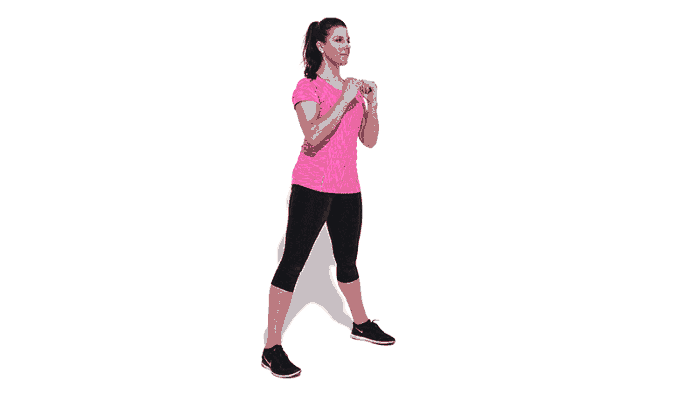Most people skip squats in the exercise routine because it can be difficult to walk after doing a squat exercise. And contrary to what most people think, squats are not just for building the leg muscles. They also help to improve pelvis floor muscles.
Squats are one of the recommended exercises for pregnant mums used to induce labor. Not only does it help to position the baby to sit on the pelvis, it also helps mothers push effortlessly when the weight is resting on the cervix.
Incorporating squats in your workout programs can help sculpt your lower body to your wildest dreams. Because of its immense benefits, I do a minimum of thirty squats three times a week for my quads and hamstrings.
I mentioned that I’m doing a four-week weight loss challenge, and I’m happy to announce that I have hit my goal of losing 12 pounds, but I will still continue the challenge until the last day.
Since my target areas are my tummy and butt, I’m doing kegel and squat workouts but at a low frequency.
I used to be so scared and sometimes avoided squats completely because it hurt until I found out I was doing my squats wrong.
How to do squats properly to bum fat
The squat is a multi-joint exercise that primarily strengthens the hamstrings, hips, quadriceps, and glutes.
The gluteus maximus (comprising gluteus maximus, gluteus medius, and gluteus minimus) is one of the major muscles you must activate to lose bum fat. This muscle doesn’t fully engage when you squat until your knees pass 90 degrees.
The muscles that are activated within the first 90 degrees are the adductor magnus and the quads.
The adductor magnus muscle of the inner thigh allows the hips to extend fully, while the quads are the primary muscles used to extend the knee.
How to do squats: Stand with your feet slightly wider than hip-width apart, toes slightly pointed, and hands clasped against your chest for balance.
Begin the movement by pushing your hips back, then bend your knees in a sitting position while keeping the chest lifted.
You should lower down until thighs are at least parallel to the floor.
Press your weight on your heels and engage glutes for ten seconds, then return to the starting position.
We make some mistakes in glute workouts, but the most common is not bending our knees low enough when squatting.
Squats ensure that your glutes are firm. However, to activate the glutes muscles every time you squat, widen your stance and lower a bit past a 90-degree bending of your knees.
Best squat exercises for bum
Doing glute activation exercises as part of your squat warm-up — or even every morning when you wake up — can help your body relearn how to fire up your rear.
There are a lot of squat exercises that work lower body muscles. But, since I’m targeting the gluteus muscles, the two main squats I do are lateral squats and plies squats.
Activating the glute muscles can be challenging, so if you can go heavy like 100 squats daily, you will speed up your progress 10x.
But if you are the conservative type like me, then 20 to 30 squats is enough to burn bum fat and build lower body muscles.
Lateral squats
Lateral squats mainly target your gluteus medius — the part of your butt flexible — as well as your quads and hip adductors.
It also works your hamstrings and calves. So, adding them to your routine will help you strengthen and sculpt your lower body from all angles.
How to: Spread your feet so that they are wider than your hips and your knees and toes are pointing forward.
Shift your weight to your right heel, push your hips back and bend that knee while keeping your left leg straight.
Try to get your thigh parallel to the floor. You can bring your arms in front of you as a counterbalance or clasp them at your chest.
Then, drive through your right foot to reverse the movement.
Pause at the top to squeeze your glutes and stretch the front of your hips forward.
Then repeat the process on left side.
Plie squat
The plie squat is a lower body strengthening exercise. It helps strengthen and tone your hamstrings, glutes, quads, and calves.
It also provides the added benefit of opening up your hips and helping to improve your hip range of motion.
How to: Stand with your feet apart between 45 to 90 degrees. It should be wider than shoulder-width, arms at your sides, and point your toes out at an angle.
Keep your back is straight, your crown pulled towards the ceiling and squat down.
Make sure when you squat, your knees are aligned to your toes.
Return to the standing position and push down again.
Repeat the moves 15 times in 2 sets. You can do three to four sets up to three times a week.
If you want to beef up your workout, you can add weights to increase the intensity of bent squats and train your upper body for extra muscle gain.
Parting words
You don’t have to feel sore every time you exercise. It doesn’t mean you’re not getting a good workout, and it doesn’t mean your muscles aren’t growing and changing.
When you do squats, you should feel the tension in your legs. If you’re experiencing lower back pain, you’re probably doing it wrong. This means the weight is on your lower back muscles rather than your glutes and quads.
Be careful when squatting. If you feel tension in your lower back, adjust how you hold your weight until you feel pressure in your legs.
About author
Jessey Anthony is a motivational speaker, fitness coach and relationship expert who helps people become confident in themselves in any challenges they face in life. Sign up to my newsletter & more cool stuff.





